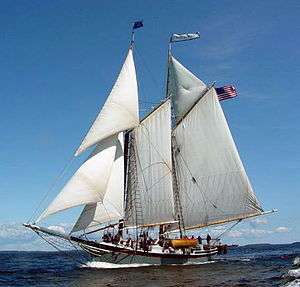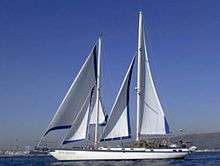Schooner
A schooner (/ˈskuːnər/) is a type of sailing vessel defined by its rig: fore-and-aft rigged on all of 2 or more masts and, in the case of a 2 masted schooner, the foremast generally being shorter than the mainmast. A common variant, the topsail schooner also has a square topsail on the foremast, to which may be added a topgallant and other square sails, but not a fore course, as that would make the vessel a brigantine. Many schooners are gaff-rigged, but other examples include Bermuda rig and the staysail schooner.[1]:211[2]:26[3]:100



The origins of schooner rigged vessels is obscure, but there is good evidence of them from the early 17th century in paintings by Dutch marine artists. The name "schooner" first appeared in eastern North America in the early 1700s.[4] The name may be related to a Scots language word meaning to skip over water,[5] or to skip stones.[6]
History
It is not known when the rig now termed "schooner" appeared. The earliest known illustration of a schooner depicts a yacht owned by the burgomasters of Amsterdam, drawn by the Dutch artist Rool and dated 1600. Later examples show schooners in Amsterdam in 1638 and New Amsterdam in 1627. Paintings by Van de Velde (1633–1707) and an engraving by Jan Kip of the Thames at Lambeth, dated 1697, suggest that schooner rig was common in England and Holland by the end of the 18th century. The Royal Transport was an example of a large British-built schooner, launched in 1695 at Chatham.[7]:233[3]:13[8]
The type was further developed in British North America starting around 1713.[5] In the 1700s and 1800s in what is now New England and Atlantic Canada schooners became popular for coastal trade, requiring a smaller crew for their size compared to then traditional ocean crossing square rig ships,[9] and being fast and versatile.[10] Three-masted schooners were introduced around 1800.[8]
Schooners were popular on both sides of the Atlantic in the late 1800s and early 1900s. By 1910, 45 five-masted and 10 six-masted schooners had been built in Bath, Maine and other Penobscot Bay towns. The Thomas W. Lawson was the only seven-masted schooner built.
Although highly popular in their time, schooners were replaced by more efficient sloops, yawls and ketches[10] as sailboats, and in the freight business they were replaced by steamships, barges, and railroads.[11]
Rig types
Various types of schooners are defined by their rig configuration. Most have a bowsprit although some were built without one for crew safety, such as Adventure.
The following varieties were built:

- Grand Banks fishing schooner: similar to Bluenose, includes a gaff topsail on the main mast and a fisherman's staysail. In the winter this would sail as a two-masted fishing schooner, without topmasts and their upper sails.[12]
- Square topsail schooner: includes square topsails.[12] A version with raked masts and known for its great speed, called the Baltimore Clipper was popular in the early 1800s.
- Four masted schooner: this design spread the sail area over many smaller sails, at a time when sails were hoisted by hand. These were used for coastal trade on the Atlantic coast of North America, the West Indies, South America, and some trans-Atlantic voyages.[12]
- Tern schooner: a three masted schooner very popular between 1880 and 1920.[12] Wawona, the largest ever built, sailed on the West Coast from 1897 to 1947.
Uses
Schooners were built primarily for cargo, passengers, and fishing.
The Norwegian polar schooner Fram was used by both Fridtjof Nansen and Roald Amundsen in their explorations of the poles.
Bluenose was both a successful fishing boat and a racer. America, eponym of America's Cup, was one of the few schooners ever designed for racing. This race was long dominated by schooners. Three-masted schooner Atlantic set the transatlantic sailing record for a monohull in the 1905 Kaiser's Cup race. The record remained unbroken for nearly 100 years.[13]
Gallery
 Åland 1988 schooner Ingrid
Åland 1988 schooner Ingrid Faroe Islands stamp of schooner Sanna
Faroe Islands stamp of schooner Sanna.jpg) The four-masted Margaret Todd
The four-masted Margaret Todd Two-masted gaff schooner
Two-masted gaff schooner Topsail schooner
Topsail schooner Staysail schooner "Rich Harvest"
Staysail schooner "Rich Harvest"
See also
References
- Palmer, Joseph (1975). Jane's Dictionary of Naval Terms. London: Macdonald and Jane's Limited. ISBN 0 356 08258 X.
- Cunliffe, Tom (2016). Hand, Reef and Steer: Traditional Sailing Skills for Classic (second ed.). Adlard Coles. ISBN 147292522X.
- MacGregor, David R. (1982). Schooners in Four Centuries. Hemel Hempstead: Argus Books Ltd. ISBN 0 85242 774 3.
- "schooner". Dictionary.com. Retrieved 4 June 2019.
- Wallenfeldt, Jeff. "Schooner". Encyclopedia Britannica. Retrieved 4 June 2019.
- "schooner". Online Etymology Dictionary. Retrieved 4 June 2019.
- Leather, John (1970). Gaff Rig. London: Adlard Coles Limited. ISBN 0 229 97489 9.
- Marquardt, Karl Heinz (2013). The global schooner: origins, development, design and construction 1695–1845. Conway Maritime. pp. 7–13. ISBN 9780851779300. Retrieved 4 June 2019.
- . Encyclopædia Britannica (11th ed.). 1911.
- "What's in a Rig – The Schooner". American Sailing Association. Retrieved 4 June 2019.
- "The Great Coal Schooners". Penobscot Marine Museum. Retrieved 4 June 2019.
- "Sailing Ship Rigs". Maritime Museum of the Atlantic. Nova Scotia Museum. Retrieved 4 June 2019.
- Ramsey, Nancy (2005-06-02). "YACHT RACING; Schooner Breaks Century-Old Record for Crossing the Atlantic". New York Times. Retrieved 2010-04-25.